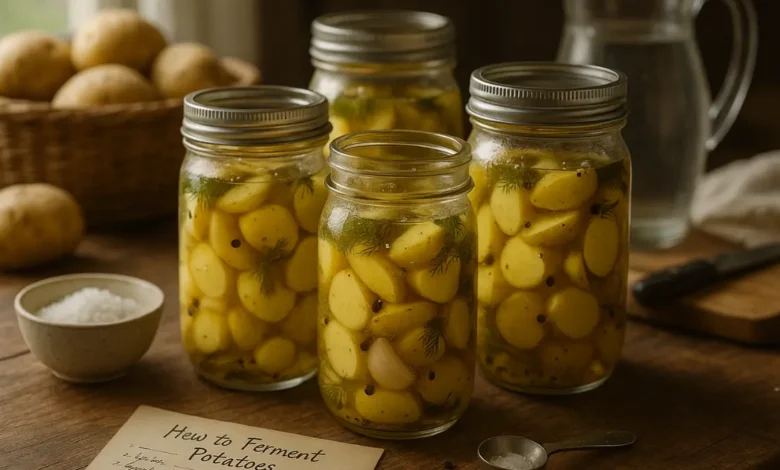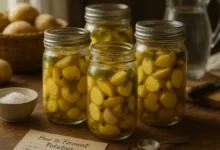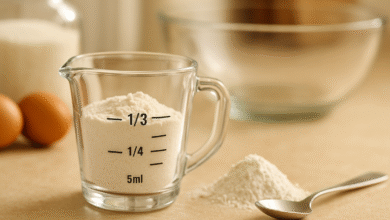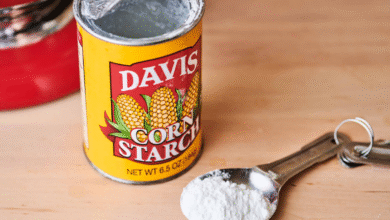How to Ferment Potatoes for Gut Health and Flavorful Homemade Results

Learn how to ferment potatoes step-by-step using natural ingredients and simple methods. Enhance flavor, preserve freshness, and boost gut health with perfectly fermented potatoes.
Fermenting potatoes may sound unusual, but it’s actually an ancient food preservation and flavor-enhancement technique that’s regaining popularity in modern kitchens. From probiotic-rich snacks to deeper flavors for cooking and distilling, knowing how to ferment potatoes can completely change how you use this humble root vegetable. Let’s explore everything — from preparation to fermentation methods, benefits, flavor results, and troubleshooting — so you can confidently ferment potatoes at home like a pro.
Understanding the Basics of Potato Fermentation
Fermentation is the process in which natural bacteria convert sugars and starches into lactic acid. When you ferment potatoes, this process not only preserves them but also improves their digestibility and nutritional value. Raw or lightly cooked potatoes contain starches that bacteria can act upon, producing a tangy, earthy flavor with subtle sour notes.
The idea of fermenting potatoes isn’t entirely new. Many cultures have used fermentation for root vegetables to extend shelf life through the winter. The lactic acid formed during fermentation acts as a natural preservative, preventing spoilage while maintaining texture and nutrients.
Why You Should Ferment Potatoes
One of the most exciting reasons to learn how to ferment potatoes is the health benefit. Fermented foods are rich in probiotics that promote gut health, improve digestion, and support your immune system. Potatoes, when fermented, develop prebiotic resistant starch — a form of fiber that feeds beneficial gut bacteria.
Beyond health, fermentation also enhances flavor. The earthy neutrality of potatoes takes on tangy, slightly funky notes that complement various dishes. Whether you mix them into salads, fry them lightly, or use them in rustic soups, fermented potatoes bring a new dimension of taste.
Choosing the Right Potatoes for Fermentation
Not all potatoes behave the same way when fermented. Starchy varieties like Russets ferment faster but tend to soften more quickly. Waxy potatoes like Yukon Gold or Red potatoes, on the other hand, retain their structure better during the process.
For best results, choose firm, unblemished potatoes without sprouts or green patches. Organic potatoes are ideal because they’re free from chemicals that might inhibit bacterial activity during fermentation.
Expert Tip: Always wash and peel your potatoes before fermenting, especially if they are not organic. The skin can carry dirt and compounds that affect fermentation consistency.
Preparing Potatoes Before Fermenting
Preparation plays a major role in successful fermentation. First, scrub your potatoes under cold running water to remove all traces of soil. Then peel them if desired — peeling helps achieve a cleaner flavor. Cut the potatoes into even pieces or slices. Smaller pieces ferment faster due to greater surface exposure.
Once cut, soak the potatoes in cold water for about half an hour. This step helps remove some of the surface starch, preventing a slimy texture later. After soaking, drain and rinse them thoroughly before packing them into jars.
Quote:
“The key to good fermentation is consistency in preparation. Treat every piece of potato with equal care — your bacteria will thank you later.” — Fermentation Specialist, Emily Cole
Crafting the Perfect Brine for Fermented Potatoes
A good brine is the foundation of successful fermentation. The salt not only flavors the potatoes but also controls bacterial growth, encouraging the good kind while suppressing the bad. For fermenting potatoes, a 2% to 3% salt solution works best. This equals roughly one tablespoon of sea salt per two cups of water.
Dissolve non-iodized salt in filtered or spring water. Avoid tap water that contains chlorine or chloramine, as these chemicals inhibit fermentation. Once the brine is ready, pour it over the potatoes in a clean glass jar, leaving about an inch of headspace at the top.
Add optional flavor enhancers such as garlic, bay leaves, peppercorns, or dill. These additions infuse your potatoes with subtle aroma while maintaining balance.
Step-by-Step Process of Fermenting Potatoes
Start by placing your prepared potatoes in sterilized jars. Pour the brine solution until the potatoes are completely submerged. It’s vital that no piece floats above the liquid; exposure to air can lead to mold. Use a fermentation weight or a clean cabbage leaf pressed on top to keep everything submerged.
Cover the jar loosely with a lid or cloth to allow gas to escape. Store it at room temperature, ideally between 65°F and 75°F, away from direct sunlight. Within a few days, you’ll notice small bubbles forming — a sign that fermentation has begun.
Taste after several days. If the potatoes have developed a pleasantly sour and tangy flavor, you can move them to the refrigerator to slow down fermentation. The longer they sit, the deeper and funkier the flavor becomes.
Ideal Fermentation Time and Storage
The fermentation duration depends on temperature, potato type, and personal preference. Generally, it takes around five to ten days at room temperature. Cooler environments slow the process, while warmer temperatures accelerate it. Always taste periodically to find your preferred balance of tanginess and texture.
Once fermented to your liking, transfer the jar to the refrigerator. Cold storage halts most bacterial activity, stabilizing the flavor and extending shelf life for several months. Always ensure the potatoes remain submerged in brine to prevent spoilage.
Flavor Variations and Creative Uses
Fermented potatoes can be customized endlessly. You can experiment with spices, herbs, and even mild chili to create diverse taste profiles. A brine with turmeric and cumin produces a warm, earthy flavor reminiscent of Indian cuisine. Adding dill and garlic yields a profile similar to classic pickles.
Once fermented, potatoes become a versatile ingredient. You can mash them into tangy spreads, toss them into salads, or roast them for a crispy yet tangy bite. Some even blend fermented potatoes into sauces for a unique umami kick.
Nutritional and Health Benefits
Fermented potatoes offer both taste and health advantages. The fermentation process breaks down complex starches, making them easier to digest. It also increases the availability of vitamins like B-complex and enhances mineral absorption.
Probiotic bacteria formed during fermentation support healthy gut flora, improving overall digestion and nutrient uptake. They can also boost immunity and may help reduce inflammation in the digestive tract. In short, fermented potatoes are not just flavorful—they’re functional food for your gut health.
| Nutrient Aspect | Benefit from Fermentation |
|---|---|
| Resistant Starch | Promotes gut health and satiety |
| Lactic Acid | Acts as a natural preservative |
| Probiotics | Supports digestive balance |
| Vitamin B Increase | Enhances energy metabolism |
Common Mistakes When Fermenting Potatoes
Even experts encounter challenges. One common mistake is using too little salt, which allows harmful bacteria to thrive. Always measure accurately. Another issue is insufficient submersion — potatoes exposed to air can develop mold or discoloration.
Using chlorinated water is another pitfall. Chlorine kills beneficial bacteria and stalls fermentation. Always use filtered or non-chlorinated water. Lastly, avoid tightly sealing jars during the active phase; gas buildup can cause pressure or spills.
Quote:
“Fermentation is a living process. Don’t fight nature—guide it with balance, patience, and clean technique.” — Chef Raymond Miller
Troubleshooting Unusual Results
If your potatoes develop a white film on the brine surface, don’t panic — it’s likely harmless yeast called kahm yeast. You can skim it off and continue. However, if you notice fuzzy mold, off smells, or black discoloration, discard the batch immediately.
Slimy texture can indicate over-fermentation or too much starch left on the potatoes. Next time, soak and rinse them longer before fermenting. Taste and adjust; every kitchen has its own microbial environment, so minor variations are normal.
Fermented Potatoes in Global Cuisine
Around the world, fermentation traditions vary. In Eastern Europe, fermented root vegetables are common in winter diets. In Korea, variations similar to kimchi use potatoes alongside cabbage and radish. In Andean regions, naturally fermented potatoes known as “chuño” are freeze-dried for preservation.
These cultural practices show how fermentation transforms simple ingredients into long-lasting, flavorful staples. By learning how to ferment potatoes, you join a culinary heritage that values sustainability and health through natural preservation.
Pairing Fermented Potatoes with Other Foods
Fermented potatoes pair beautifully with rich and savory foods. Their tanginess cuts through fatty meats, enhancing balance. Try them alongside grilled fish, roasted chicken, or smoky sausages. You can also incorporate them into breakfast dishes, mixed with eggs or added to hash browns for a surprising twist.
They also make fantastic accompaniments for cheese platters, offering acidity to balance creamy textures. When blended into dips or spreads, fermented potatoes add complexity that elevates simple ingredients.
Advanced Fermentation Techniques
For those ready to experiment further, consider adding a starter culture like whey or a spoonful of sauerkraut brine to jump-start the process. This method introduces active bacteria right away, speeding up fermentation and ensuring consistency.
You can also play with partial cooking — blanch the potatoes briefly before fermenting. This softens them slightly and gives a milder tang, ideal for those new to fermentation flavors. Some fermenters even experiment with smoking fermented potatoes for layered taste.
Safety and Hygiene Tips
Cleanliness is critical. Always sterilize jars and utensils before use. Wash hands thoroughly, and ensure your workspace is free of contaminants. Avoid metal containers since acid from fermentation can react with metal surfaces, altering the taste.
If in doubt about a batch’s safety, throw it out. Trust your senses—sour aroma and tangy flavor are good signs, but foul or rotten smells indicate spoilage. Keeping notes on each batch helps you improve consistency over time.
Environmental and Sustainability Benefits
Fermenting potatoes reduces food waste and promotes sustainability. Instead of throwing away surplus potatoes, you can transform them into long-lasting, probiotic-rich food. Fermentation requires no electricity beyond refrigeration, making it an eco-friendly preservation method.
It also supports local agriculture by encouraging use of seasonal produce. With climate concerns growing, traditional techniques like fermentation offer a sustainable, low-impact way to enjoy nutritious food year-round.
Quotes from Experts and Home Fermenters
“Fermentation is both art and science — potatoes provide the perfect canvas for both.”
— Dr. Lydia Harper, Food Scientist
“When I started fermenting potatoes, I realized how much depth and nutrition I’d been missing. It’s a game changer for everyday cooking.”
— Sarah Knight, Home Fermenter
These testimonials reflect how transformative and accessible fermentation can be for anyone willing to experiment.
FAQs about How to Ferment Potatoes
Q1. Can I ferment cooked potatoes instead of raw ones?
Yes, you can lightly boil or steam potatoes before fermenting. However, fully cooked potatoes tend to break apart, so partial cooking is best for maintaining texture.
Q2. How do I know when the potatoes are properly fermented?
You’ll notice small bubbles, a tangy aroma, and a slightly sour taste. The brine should remain clear or slightly cloudy, never foul or moldy.
Q3. Can I reuse the brine for another batch?
Yes, but only once. The old brine contains active bacteria that can kick-start a new batch, though the flavor might intensify faster.
Q4. What’s the best temperature for fermentation?
Room temperature — ideally around 68°F to 72°F — is perfect. Cooler temperatures slow the process, while warmer ones accelerate it.
Q5. Are fermented potatoes safe for everyone?
Generally yes, but if you’re immunocompromised or have digestive issues, consult a healthcare provider before consuming fermented foods regularly.
Conclusion
Fermenting potatoes is a rewarding and enriching process that blends traditional wisdom with modern nutrition. Once you understand how to ferment potatoes, you unlock new possibilities for taste, health, and sustainability. From gut-boosting probiotics to distinctive flavor, fermented potatoes deserve a place in every creative kitchen. With clean preparation, patience, and curiosity, you can master this timeless craft and enjoy your potatoes in an entirely new light.





